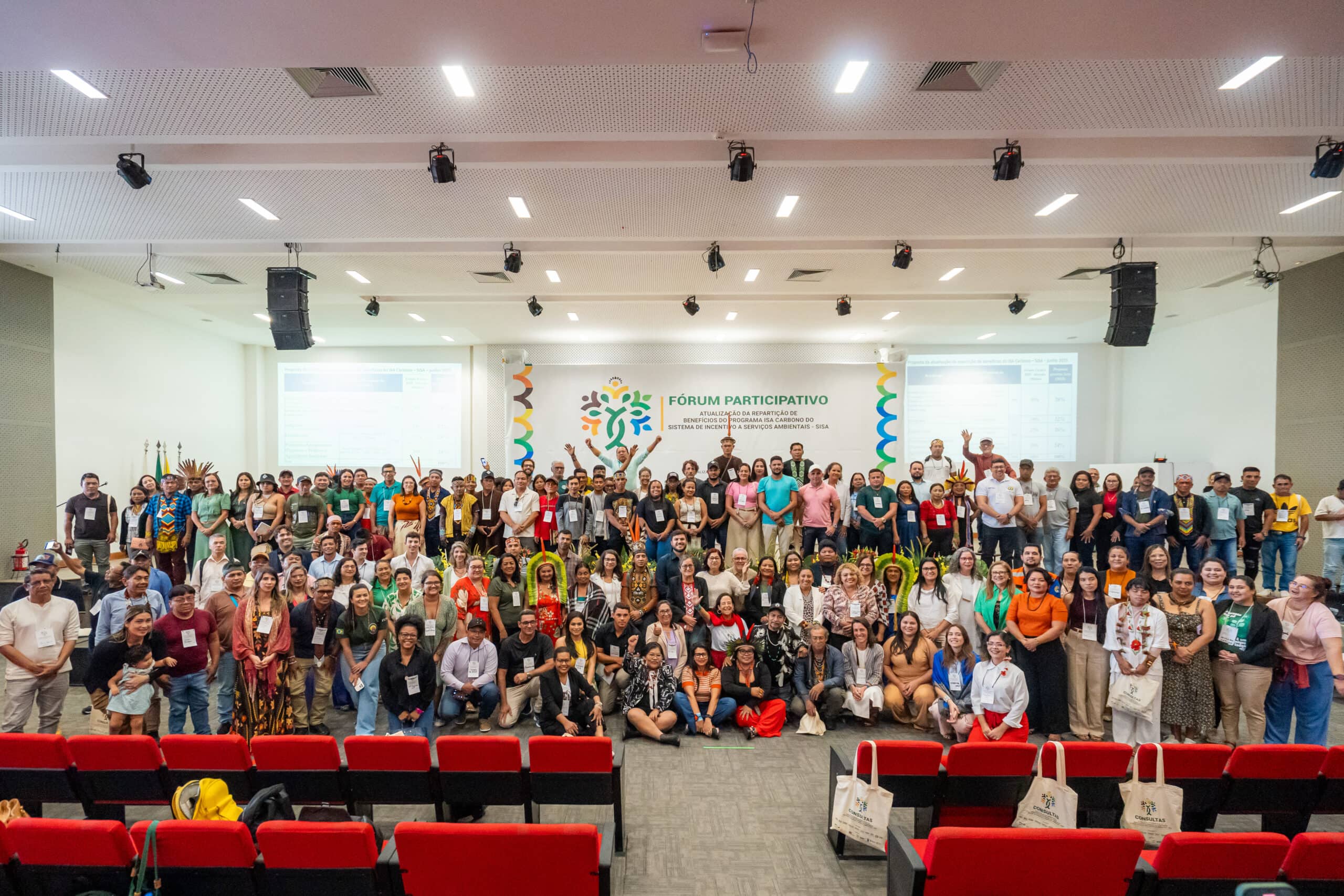In a historic milestone, the government and representatives of indigenous peoples and traditional communities define new percentages for the distribution of benefits from the Isa Carbono program. The Governors’ Climate and Forests Task Force is posting the official announcement translated into English with permission from the Acre government. For the original Portuguese post, see here.
By Ângela Rodrigues, Instituto de Mudanças Climáticas e Regulação de Serviços Ambientais
In a historic milestone for environmental policy promoting environmental services and valuing forest peoples, the government of Acre, through the Institute for Climate Change and Environmental Services Regulation (IMC), held a Participatory Forum on Thursday and Friday, June 12 and 13, which defined the new percentages for the distribution of benefits from the ISA Carbon Program, consolidating a new cycle of social participation and strengthening Jurisdictional REDD+.
The event, held in the auditorium of Uninorte, in Rio Branco, brought together 150 delegates elected in the five regions, representing indigenous territories, extractive communities, riverine communities, and family farmers in the state of Acre.
In working groups, the representatives debated and then defended in plenary the percentages for future collections from climate funds in REDD+. The new proposal, approved collectively, establishes the following distribution among the segments represented:
Indigenous Territories: 22%; Extractive Territories: 26%; Agricultural Producers (small and medium) and family farmers: 24% and 28% for the state government to implement public policies in REDD+, which include command and control actions, strengthening governance bodies and the efficiency of Sisa, as well as the management of public areas, non-designated areas, and conservation units.

Indigenous leaders discussed the new distribution percentages in a participatory forum. Photo: cedida.
The event was attended by international observers, researchers, experts, and representatives from the Norwegian Agency for Development Cooperation (Norad), the United Nations Climate and Environment Program (UNDP), the Earth Innovation Institute (EII), the Environmental Defense Fund (EDF), and German Cooperation GIZ.
There were also representatives from the National Foundation for Indigenous Peoples (Funai); Chico Mendes Institute for Biodiversity Conservation (ICMBio); the Public Prosecutor’s Office; the State Public Defender’s Office (DPE) and the State Attorney General’s Office (PGE).
Representatives from the National Council of Extractive Populations (CNS); the Pro-Indigenous Commission of Acre (CPI-Acre); SOS Amazon; the Association of Indigenous Agroforestry Agents of Acre; the Federation of Rural Workers and Family Farmers of the State of Acre (Fetacre); and the Ombudsmen of Sisa and DPE.
Historical milestone
At a time when the planet is crying out for real solutions, Acre reaffirms its leading role in REDD+ policies and expands opportunities for raising climate funds with the definition of a new benefit-sharing strategy. This step also represents the fulfillment of another requirement for obtaining the ART Trees standard of environmental excellence in the generation of high-integrity carbon credits.
The update is the result of an active listening process that began in December last year at the request of leaders and representatives of organized civil society, who make up the governance of Sisa. They advocated to the state government for participatory listening through consultations in the five regions.
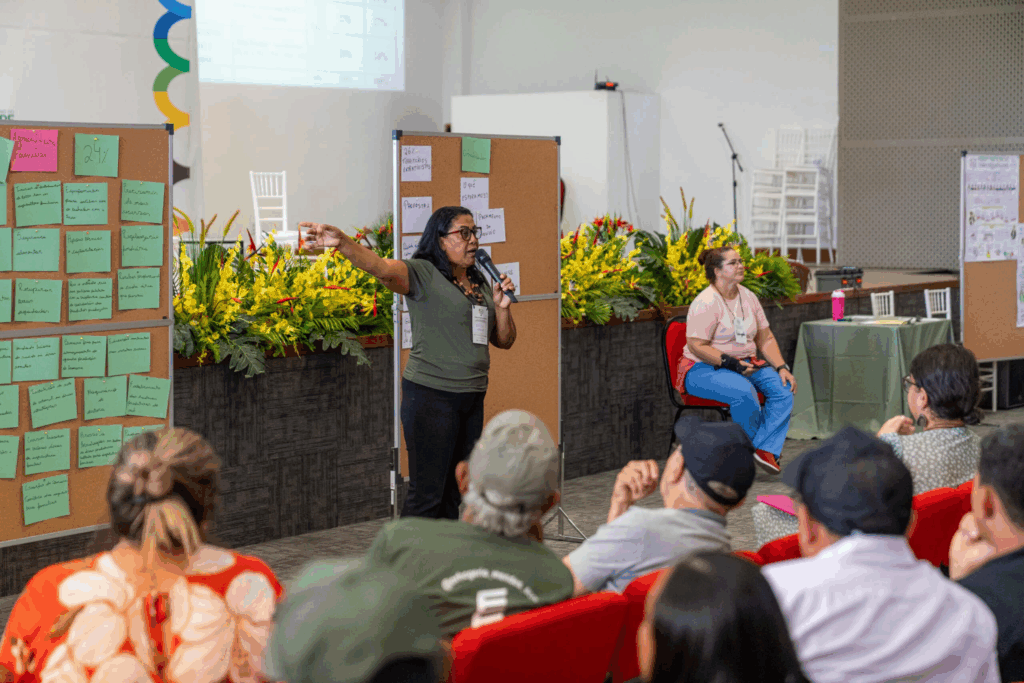
The extractive sector defended percentages of 26% in the update of the distribution. Photo: cedida
Throughout the process, indigenous people, extractivists, riverine communities, and family farmers received training on the entire topic and were kept abreast of the technical study conducted by the government with support from international partners, which guided the debates on the new percentages. The consultations began in April and ended in June.
Implementation and partnerships
The update process, which included two participatory forums, pre-consultations in hard-to-reach areas, and six regional consultations, is an initiative of the Acre government, through the IMC, with support from the Secretariat for Indigenous Peoples (Sepi), the State Secretariat for the Environment (Sema), the State Planning Secretariat (Seplan), through the REM Acre Phase II Program, the State Finance Secretariat (Sefaz), and the Environmental Development and Services Company (CDSA).
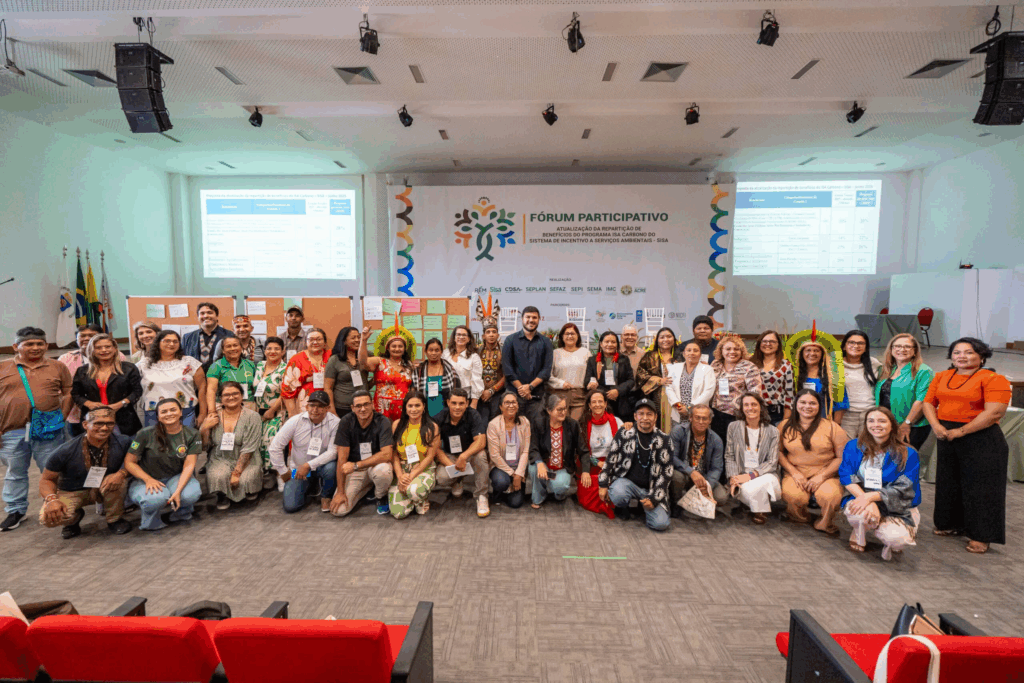
The Acre government benefited from the valuable contribution of Sisa governance members and partnerships with international organizations. Photo: cedida
The government of Acre has partnerships with the following international organizations: Norwegian Agency for Development Cooperation (Norad), Embassy of Norway and the United Kingdom, United Nations Climate and Environment Program (UNDP), Earth Innovation Institute (EII), Environmental Defense Fund (EDF), German Cooperation GIZ, and Kawari Foundation.
What they said
“We are happy because we have fulfilled the determination of our governor Gladson Camelí to conduct this process with dialogue and respect for indigenous peoples, extractivists, family farmers, and riverine communities. They walked side by side with the government in building this process in a participatory manner, making valuable contributions, defending their interests and their percentages, and together we reached a consensus. This represents the strengthening of Acre’s Jurisdictional REDD+, of governance bodies, and also opens up new opportunities for the state to access climate funds and generate benefits for the forest peoples.”

IMC president Jaksilande Araújo reinforces the government’s commitment to strengthening Jurisdictional REDD+ and governance bodies. Photo: archive/IMC
“We, from family farming, have been working in workshops, regional meetings, and consultations in the five regions. We reached an agreement on 24%. It was an achievement, a struggle, everyone worked hard to understand what REDD+ is. We will strengthen our family farming chamber so that we can monitor this 24% and strengthen small and medium-sized producers and family farming. Our main goal is to preserve the Amazon, our biodiversity, and strengthen Sisa: a state policy that has worked well, and we will be here, within family farming, strengthening it.”

Lisiane Pedrosa, member of the Sisa governance and representative of Fetacre, reinforced her commitment to family farming. Photo: archive/IMC
“This whole process was built together with the Sisa governance, and we reached a consensus on the numbers for this distribution of benefits. Governor Gladson Camelí’s historic recognition of indigenous peoples was very important, raising the percentage from 12% to 22%. These are peoples who have suffered greatly from climate change and extreme events and need this care. In addition, we also had significant percentages for extractivists and family farmers, beneficiaries of Sisa, who have been implementing this pioneering policy, which is a reference for the world.”
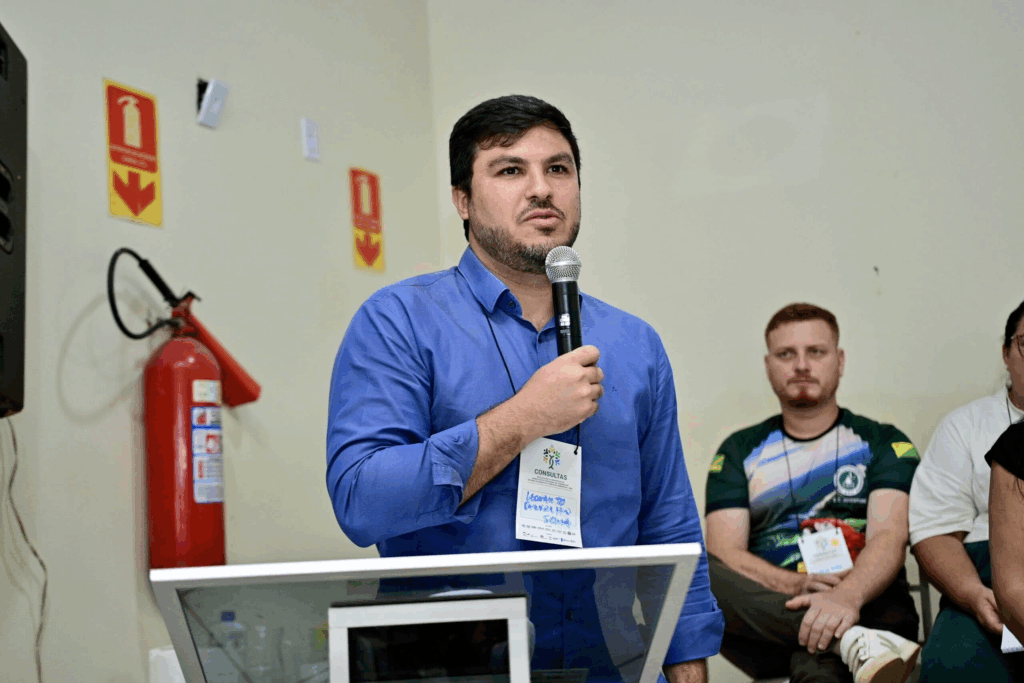
Leonardo Carvalho, Secretary of Sema Photo: archive/IMC
“Before, we [indigenous people] had 12%. The government’s technical study showed 19%, but the indigenous leaders who participated and followed this movement understood that this was not enough to serve the 36 indigenous lands in Acre. So, for this reason, we made a demand to the state government to reach 22%. The government accepted our proposal, which was a consensus agreement so that no one loses out, neither the government, nor the extractivists, nor family farmers, nor other categories. We know that this resource will not solve everything, but we want this resource to be reflected at the grassroots level so that communities have the opportunity to work in their activities, in their interests on indigenous lands.”

Lucas Manchineri is coordinator of the Indigenous Thematic Chamber (CTI) of Sisa and leader of the Mamoadate Indigenous Land. Photo: IMC archive
“It was a long process that we began in December 2024, very rich in collective construction and learning together with the extractive communities, women, and other segments as well. We are here at a historic moment, finalizing this process of defining the percentages, from my point of view, in the fairest way possible for all segments that make up this program. We are very happy and now we have new challenges.”
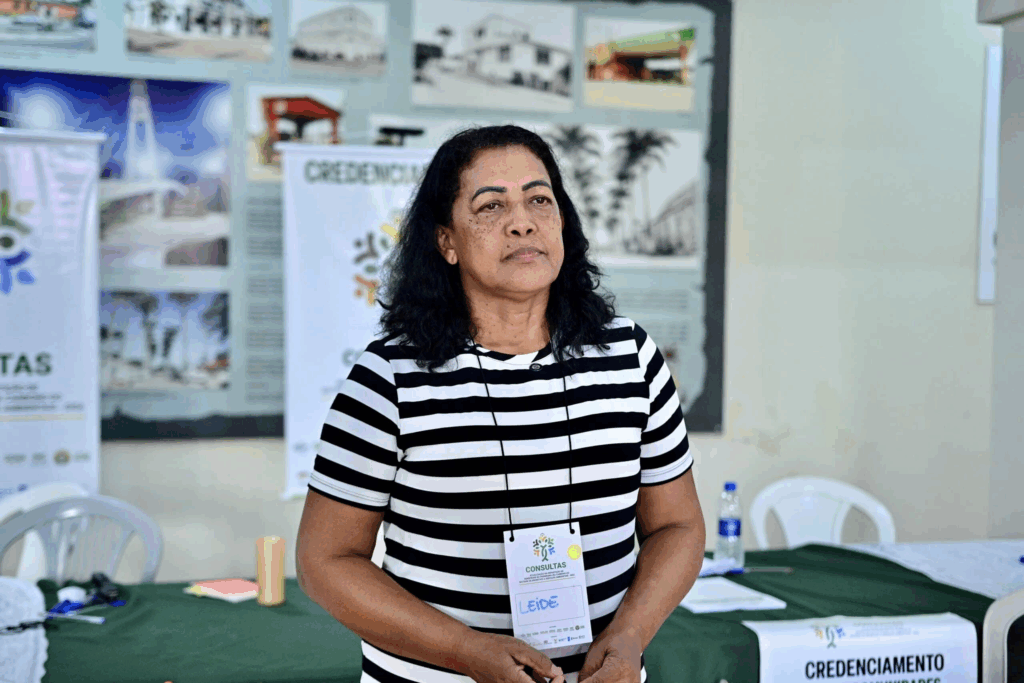
Leide Aquino is coordinator of the Women’s Thematic Chamber (CTM) of Sisa and president of the Alto Acre Women’s Forum. Photo: IMC archive
“We have completed this important stage. Now we need to raise funds, think about the mechanisms and criteria for how the funds will reach the communities and territories. Acre is truly committed to the indigenous agenda because we are a barrier to halting deforestation and fighting fires. We are facing extreme events and are more vulnerable. So I leave here with a joyful heart, and even moved, to see this beautiful work that we have done in the remote areas, in the regions, and we close the forum with this result, which the world is watching, waiting for this result.”
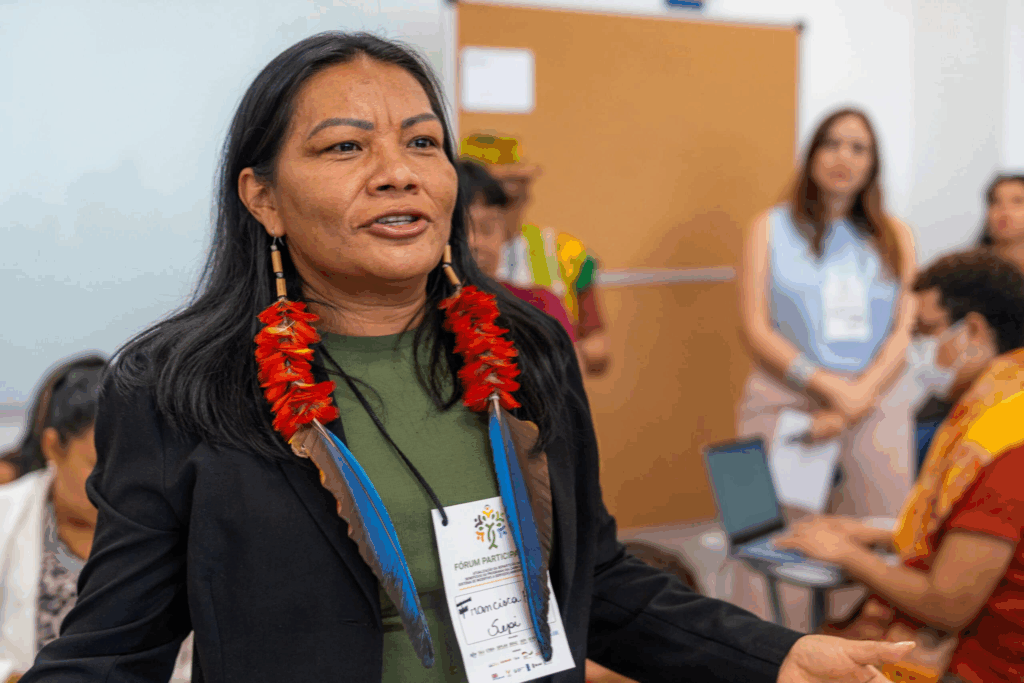
Francisca Arara, Secretary for Indigenous Peoples, reinforces the government’s commitment to the indigenous agenda. Photo: Pedro Henrique/Sepi
“The CDSA was subordinated to Sefaz as a negotiating body, monitoring the entire process of reviewing the benefit sharing strategy. This is a fundamental step towards generating high integrity carbon credits that meet the requirements of our partners. The state led this process with the participation and social engagement of traditional communities, riverine communities, family farmers, and indigenous peoples. Obviously, we were eagerly awaiting the outcome of this consultation so that we could move forward with the first prospects for selling carbon credits.” – Ernandes Negreiros, presidente do Conselho de Administração da CDSA
“There are three events I am participating in on benefit sharing. There was a consultation in our community, I also went to Cruzeiro do Sul and here [the capital]. We had access to information. All our questions were answered. We hope that the government will seek these resources to strengthen our preservation work. We suffer a lot from flooding and droughts and we need the government’s help. We will return with good news for our village. We are very happy and will be able to explain everything to our relatives. We hope that these benefits will reach us at the grassroots level to help us in our struggle.”
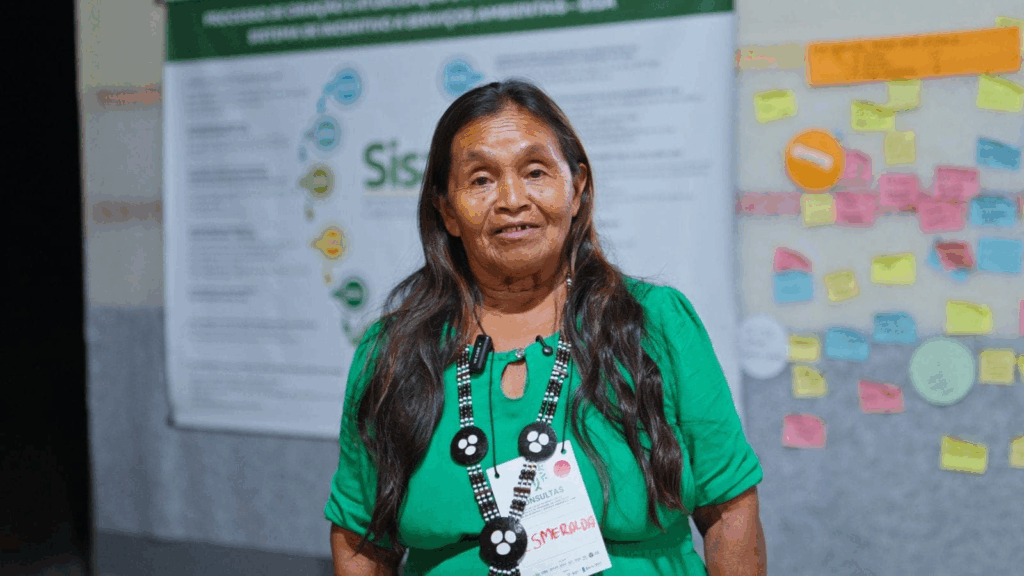
Esmeralda Arara, chief of the Nova Vida II village, in the Igarapé Preto Indigenous Territory. Photo: IMC archive
About the process of updating the distribution of benefits
Throughout the process, the state government held numerous training workshops and ensured active listening and knowledge exchange between managers and society through social participation. The consultations were timely for receiving contributions, perceptions, criticisms, and recommendations from Sisa beneficiaries. The debates reinforced the legitimacy, transparency, and effectiveness of environmental public policies and helped identify impacts, risks, opportunities, and alternatives based on the knowledge and experiences of forest peoples.
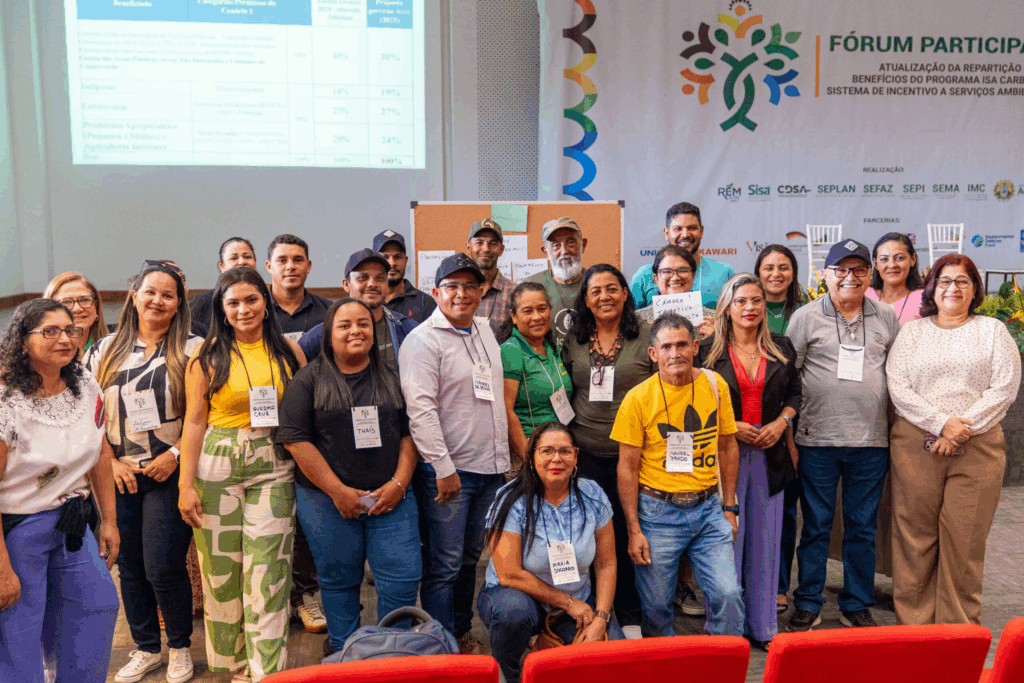
Traditional communities defended the 24% percentage in the agreement on the new distribution of benefits. Photo: cedida
Based on these contributions, the new percentages of the Isa Carbono benefit sharing, yet to be collected, should be distributed in the form of public policy to meet these demands and new regional challenges: adaptation to changes in land use, new measures to curb deforestation, and results in reducing deforestation and forest degradation.
How was it before?
Over the past 12 years, 70% of the funds raised by Jurisdictional REDD+ have been allocated to environmental service providers through public policies that benefit indigenous peoples, extractive workers, and family farmers.
These resources have been allocated to strengthening sustainable production chains (rubber, Brazil nuts, murumuru, wood, among others), technical assistance, training, reforestation, family farming, environmental and territorial management, scholarships and training for agroforestry agents, cultural strengthening, and other initiatives. The remaining 30% is allocated to the state government for command and control actions, strengthening governance bodies, and improving the efficiency of Sisa.
Sisa: a pioneer in REDD+, governance, and safeguards
Since its creation in 2010, Sisa has established itself as one of the main public environmental policies in Jurisdictional REDD+ in the country, with international recognition for its legal framework, active governance system, and socio-environmental safeguards, which are the result of recommendations received in the Free, Prior, and Informed Consultations (CLPI).
Isa Carbono is one of the seven programs of Sisa, which accredited the government of Acre to sign international cooperation agreements with Germany and the United Kingdom in 2012 to implement the world’s first jurisdictional REDD+ program, REDD Early Movers (REM).
Transparency
To ensure transparency in the consultation process, the government of Acre makes available on the website of the Institute for Climate Change (IMC), the body responsible for the technical coordination of Sisa, all technical information and documents, minutes, reports, and work plans for the consultations, and much more. For more information, click here.

